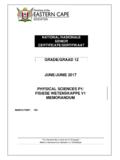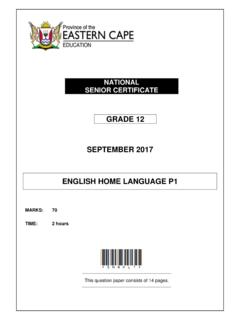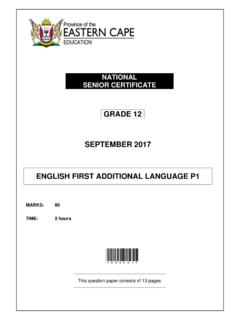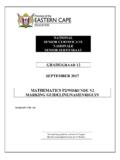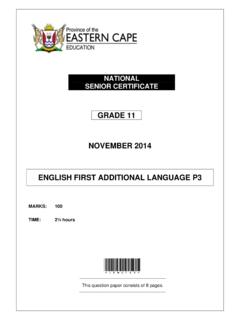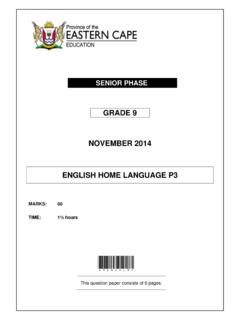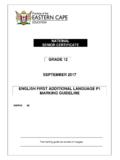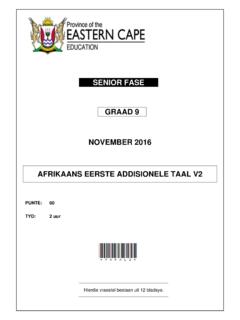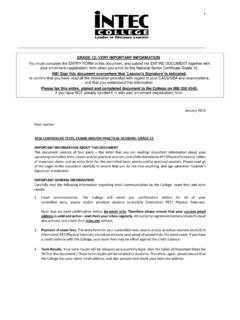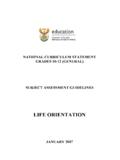Transcription of Life Orientation Examination Guidelines 2012 - …
1 life Orientation Guidelines FOR COMMON ASSESSMENT TASK grade 12 2012 These Guidelines consist of 9 pages. Copyright reserved Please turn over life Orientation 2 DBE/ 2012 NSC Examination Guidelines life Orientation grade 12 NSC GUIDELINE FOR THE COMMON ASSESSMENT TASK 1. INTRODUCTION In order to assist with the development of a common standard of assessment in life Orientation at grade 12 level, one of the five assessment tasks will be designed at all schools. The Examination administered in the third quarter will be set nationally and is in this case referred to as the Common Assessment Task. In order to assist teachers in their preparation of learners for the grade 12 common assessment scheduled for 2012 , the Department of Basic Education is providing schools with an Assessment Guideline that stipulates the minimum standards that must be covered by all learners.
2 Schools are nevertheless encouraged to ensure that all assessment standards prescribed in the National Curriculum Statement are covered. This guideline document must be read in conjunction with the Subject Assessment Guideline for life Orientation (SAG 2008), the Learning Programme Guideline for life Orientation (LPG 2008) and the National Curriculum Statement Grades 10 12 life Orientation . Some material from the Subject Assessment Guideline has been included in this document for easy reference. 2. STRUCTURE OF THE life Orientation COMMON ASSESSMENT TASK The life Orientation assessment consists of a 1 hour paper of 75 marks. The question paper is divided into three sections.
3 SECTIONS A and B are COMPULSORY. In SECTION C, learners must answer TWO of the three questions. The detailed requirements for each section are indicated below: Outline for examinations The outline provided below serves as a guideline for the setting of life Orientation Examination papers. The suggested weighting of the cognitive levels for the Examination is as follows: Weighting Cognitive level Bloom's Taxonomy Examples of verbs 30% Lower order Levels 1 & 2 What? Why?, Who?, List 40% Middle order Levels 3 & 4 Discuss, Explain, Describe30% Higher order Levels 5 & 6 Evaluate, Synthesise, Critically evaluate, Examine The following command verbs/words are included to illuminate the revised Bloom's Taxonomy: (NOTE: The definitions below are mainly from Hornby, AS.)
4 (1995) Oxford: Advanced Learner's Dictionary; Oxford University Press. Oxford. The list includes verbs used most frequently in the 'competence descriptions'. Teachers may wish to consult this, or other dictionaries, to find proper definitions of other verbs.) Copyright reserved Please turn over life Orientation 3 DBE/ 2012 NSC Examination Guidelines Analyse: to break down information into components/parts and involves recognising what is important and how the parts are related Apply: to use knowledge and understanding of life Orientation and make it relevant to a situation, issue or problem Assess: to estimate the nature, quality or value of something.
5 To make a value judgement that must be properly justified Comment: to give an opinion on, to explain or criticize an event, behaviour or a situation. Prior knowledge is essential and learners are invited to make a judgement based upon the evidence they can relate to their knowledge Compare: to examine things to see how they are alike and how they are different Design/Create: to put together ideas or elements to develop an original idea or engage in creative thinking Critically analyse: to express approval or disapproval, or to find faults or virtues and to provide reasons Define: to give the exact meaning of a term or concept using words Describe: to give an account of something (recall knowledge or state what is observed) Discuss: to talk or write about something.
6 Compare a number of possible views about an issue or problem and to weigh up their relative importance. A conclusion is essential. Do you think: invites learners to put forward their own opinions about an issue or problem. However, marks will always be awarded for the quality of the arguments put forward and not for individual opinions Evaluate: to form an idea of the amount, quality or value of something; or, to compare a number of possible views about an issue or problem and weigh up their relative importance; to make judgements on account of general criteria Examine: to look at something carefully and in detail in order to learn something about it; break down an issue or problem (as in 'analyse') and to understand it state what has been learnt Explain: to make something plain or clear, to simplify; to describe something in detail so that it can be understood.
7 Mentioning examples is essential. Identify: to single out from other information List: to state in the briefest form Copyright reserved Please turn over life Orientation 4 DBE/ 2012 NSC Examination Guidelines Mention: to write or speak something without explaining Name: Similar to 'mention' Name TWO reasons for poverty. Suggest: to give possible reasons or ideas. These must be plausible but not necessarily correct. To what extent: invites learners to explain and analyse and then comment on the relative importance of arguments SECTION A: 25 MARKS 1. All questions are COMPULSORY.
8 2. This section should incorporate all 4 Learning Outcomes. 3. The questions must be objective-type questions, testing factual knowledge. 4. Questions to vary from simple to complex. 5. The mark allocation will range between 1 2 marks. QUESTION 1: Multiple-choice 10 Items 3 lower-order questions 4 middle-order questions 3 higher-order questions (10 x 1) (10) QUESTION 2: True/False 3 5 items lower to higher order (5 x 1) (5) QUESTION 3: Matching items 5 items lower to higher order (5 x 1) (5) QUESTION 4: Questions requiring 1 2 word responses. 5 items lower to higher order (5 x 1) (5) SECTION B: 30 MARKS 1.
9 This section should incorporate all 4 Learning Outcomes. 2. The questions must be knowledge based, current, up-to-date, age appropriate and learner-friendly. 3. Questions to vary from simple to complex. 4. All questions are COMPULSORY. 5. The mark allocation will range between 2 5 marks. QUESTION 5: 1 2 items Scenario-based lower to higher order 1 item = 10 marks or 2 items = 5 marks each QUESTION 6: 1 2 items Scenario based questions lower to higher order 1 item =10 marks or 2 items = 5 marks each QUESTION 7 1 2 items Case study questions lower to higher order 1 item = 10 marks or 2 items = 5 marks each Copyright reserved Please turn over life Orientation 5 DBE/ 2012 NSC Examination Guidelines SECTION C: 20 MARKS 1.
10 Each question should focus on the content of one specific Learning Outcome or it can integrate content from different Learning Outcomes. 2. Application questions: solve problems, make decisions, give advice, etc. A short text/diagram/data can be provided as a stimulus. 3. Three (3) questions will be set of which learners will be expected to answer TWO (2). 4. Each question will carry 10 marks. The questions will require extended responses that will assess middle to higher order thinking, short written paragraphs. TOTAL FOR Examination : 75 MARKS 3. TEST GRID MARKS: 75 MINUTES: 90 LO's AS's No.

